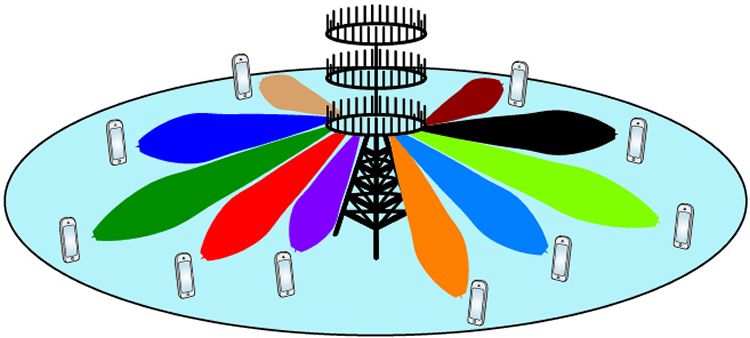
Massive MIMO technology is a core component of the super-fast 5G networks that are currently rolling out. But what exactly is Massive MIMO, and why is it so essential to the operation of 5G?
What is Massive MIMO?
MIMO stands for Multiple-input multiple-output. While it involves multiple technologies, MIMO can essentially be boiled down to this single principle: a wireless network that allows the transmitting and receiving of more than one data signal simultaneously over the same radio channel.
Standard MIMO networks tend to use two or four antennas. Massive MIMO, on the other hand, is a MIMO system with an especially high number of antennas.
There’s no set figure for what constitutes a Massive MIMO set-up, but the description tends to be applied to systems with tens or even hundreds of antennas. For example, Huawei, ZTE, and Facebook have demonstrated Massive MIMO systems with as many as 96 to 128 antennas.
Ericsson’s AIR 6468, which the company claims is "the world's first 5G NR radio", uses 64 transmit and 64 receive antennas.
What are the advantages of Massive MIMO?
The advantage of a MIMO network over a regular one is that it can multiply the capacity of a wireless connection without requiring more spectrum. Reports point to considerable capacity improvements, and could potentially yield as much as a 50-fold increase in future.
The more antennas the transmitter/receiver is equipped with, the more the possible signal paths and the better the performance in terms of data rate and link reliability.
A Massive MIMO network will also be more responsive to devices transmitting in higher frequency bands, which will improve coverage. In particular, this will have considerable benefits for obtaining a strong signal indoors (though 5G’s higher frequencies will have their own issues in this regard).
The greater number of antennas in a Massive MIMO network will also make it far more resistant to interference and intentional jamming than current systems that only utilise a handful of antennas.
It should be noted, too, that Massive MIMO networks will utilise beamforming technology, enabling the targeted use of spectrum. Current mobile networks are rather dumb in the way they apportion a single pool of spectrum between all users in the vicinity, which results in a performance bottleneck in densely populated areas. With Massive MIMO and beamforming such a process is handled far more smartly and efficiently, so data speeds and latency will be far more uniform across the network.
MIMO and 5G
While standard MIMO principles are already in use across multiple Wi-Fi and 4G standards, Massive MIMO will really come into into its own as our 5G networks develop. Indeed, Massive MIMO will be a key enabler and foundational component of super-fast mmWave 5G, which is starting to rollout in certain countries.
One of the key roles of any 5G network is to handle the huge increase in data usage that we're experiencing right now. Opensignal reports that 5G users on average consume up to 2.7x more mobile data compared to 4G users, averaging 15 GB of mobile data per month as of September 2020.
Massive MIMO’s ability to serve multiple users - and multiple devices - simultaneously within a condensed area while maintaining fast data rates and consistent performance makes it the perfect technology to address the needs of the 5G era.
Massive MIMO breakthroughs
Massive MIMO technology is already live commercially. Japan’s Softbank network deployed the first ever commercial Massive MIMO network towards the end of 2016.
In early September 2017, Ericsson announced the launch of a new FDD (Frequency Division Duplexing) radio with support for 5G and Massive MIMO. It claimed that this would bridge the gap between 4G and 5G, boosting the capacity of existing 4G LTE while forming the foundation for 5G.
Chinese network technology companies ZTE and Huawei both announced initial European Massive MIMO tests in October 2017.
Also in 2017, Vodafone and Huawei teamed up in Australia to show off Massive MIMO technology within a real world setting. They managed to use Vodafone’s existing frequency spectrum, along with Huawei’s 5G active antenna unit (featuring 32 internal transmitters and receivers) to hit transfer speeds of 717Mbps across eight devices.
Early in 2018, Nokia took a step towards refining Massive MIMO antenna technology itself with the production of its ReefShark chipset. By being smaller, lighter and more power efficient than its predecessors, Nokia claimed that ReefShark reduces the massive MIMO antenna size by half and cuts the energy consumption in baseband units by 64%. Its latest ReefShark products have improved matters further, delivering eight times the throughput of previous generations and supporting up to 90,000 simultaneous users.
Korean tech giant Samsung has also been busy with Massive MIMO technology. At its headquarters in Suwon, Korea, the company has created a so-called ‘5G City’ to provide some insight into a what life might be like when 5G is rolled out.
One major element of this 5G City was a so-called ‘5G Stadium,’ which specifically demonstrated how massive MIMO technology can enable crowds of people to simultaneously stream HD video without any delays or interruptions.
Testing the performance of multiple parallel signals has actually been quite a challenge for the telecoms industry. Cobham Wireless addressed this in March 2018 with a multi-beam Massive MIMO performance test solution it developed in conjunction with the China Mobile Research Institute. It enables testing in a virtualised environment that simulates real-world conditions, which was a step forward from the limited-scale lab tests that had preceded it.
At MWC 2019 in Barcelona, Ericsson won the award for Best Mobile Network Infrastructure with its 5G high-band Massive MIMO. This is the first ever commercial enhanced mobile broadband solution operating on millimetre wave (mmWave), aka the higher frequency bands that will come to define 5G.
These days, Massive MIMO technology is routinely rolled out to meet the exacting demands of our expanding 5G networks. Two years into 5G deployment, it's been found that Massive MIMO and other Wideband technologies "can improve user experience by 10 times and have become the choice of most operators around the world", according to Huawei.
It's not all about that super-fast mmWave spectrum either. For example, at the time of writing (November 2021), Samsung had just unveiled a new AWS/PCS Dual-band Massive MIMO Radio, which supported both the AWS and PCS mid-band spectrums in a compact form factor.
What are UK mobile networks doing with Massive MIMO?
Vodafone became the first European mobile network to deploy Massive MIMO when it commenced upgrading a number of its UK sites in June 2017. The operator targeted UK hotspots where MIMO’s key attributes could be best exploited, such as cities and sports stadiums.
Almost a year later, in April 2018, Vodafone conducted the UK’s first 3.4 GHz spectrum trial using Massive MIMO technology.
In October 2018, Vodafone launched the first full 5G UK trial in Salford. This was the first to carry full 5G over a commercial network, and it utilised Massive MIMO technology in conjunction with 3.4GHz spectrum to do so. It has since rolled these tests out to Birmingham, Bristol, Cardiff, Glasgow, Liverpool and London.
A little later than Vodafone’s test, in November 2018, O2 and Nokia teamed up to roll out two Massive MIMO trials in the King’s Cross and Marble Arch areas of London. This put to use Nokia’s Massive MIMO technology and the 2.3GHz spectrum that O2 won in the Ofcom auction of early 2018. Prior to this, O2 had revealed that it was “investing over £600m per year in innovations like Massive MIMO and 5G”.
In June 2021, Vodafone announced that it had partnered with NEC Corporation for supplying 5G massive MIMO radio units as part of its plan to build one of the largest commercial Open Radio Access Networks (RAN) in the world.
UK network EE has also been working with massive MIMO technology for some time. In November 2017 it used Massive MIMO to demonstrate download speeds of 2.8Gbps across an end-to-end 5G test network. Parent company BT worked with Nokia to implement the aforementioned ReefShark chipset into its network.
In September 2021, it was revealed that BT had partnered with Ericsson to develop the AIR 3268, which is said to be the lightest and smallest Massive MIMO radio in the industry. BT claimed that the new radio will apparently enable BT and EE to deliver an improved mid-band 5G experience to customers in urban areas.
Elsewhere, Samsung recently confirmed that it was to work with O2 in conducting commercial trials of their latest 5G Massive MIMO radios in the UK.
Do current phones support MIMO?
Massive MIMO is key to 5G's ongoing rollout, but many phones can already benefit from MIMO's unique attributes with their own multi-antenna MIMO set-ups.
For example, all recent iPhones in the iPhone 13 family support both 2x2 MIMO and 4x4 MIMO. The latter is comprised of four antennas for four simultaneous data streams, thus making it able to transfer data twice as fast as 2x2 MIMO.
The same is true of modern Android phones like the Samsung Galaxy S21 range, the Google Pixel 6, and the OnePlus 9. Indeed, the likes of the Oppo Find X3 Pro and the Xiaomi Mi 11 support 8x8 MIMO.
It’s worth noting that even older or less capable phones that don’t contain such multi-antenna support will be able to benefit from the more stable, more sensitive network environment that Massive MIMO networks will produce. What's more, phones with 4x4 MIMO support are faster even on 2x2 MIMO networks, as the two free antennas instead work to hone in on a stronger signal.
Image credit: Linkoping University










